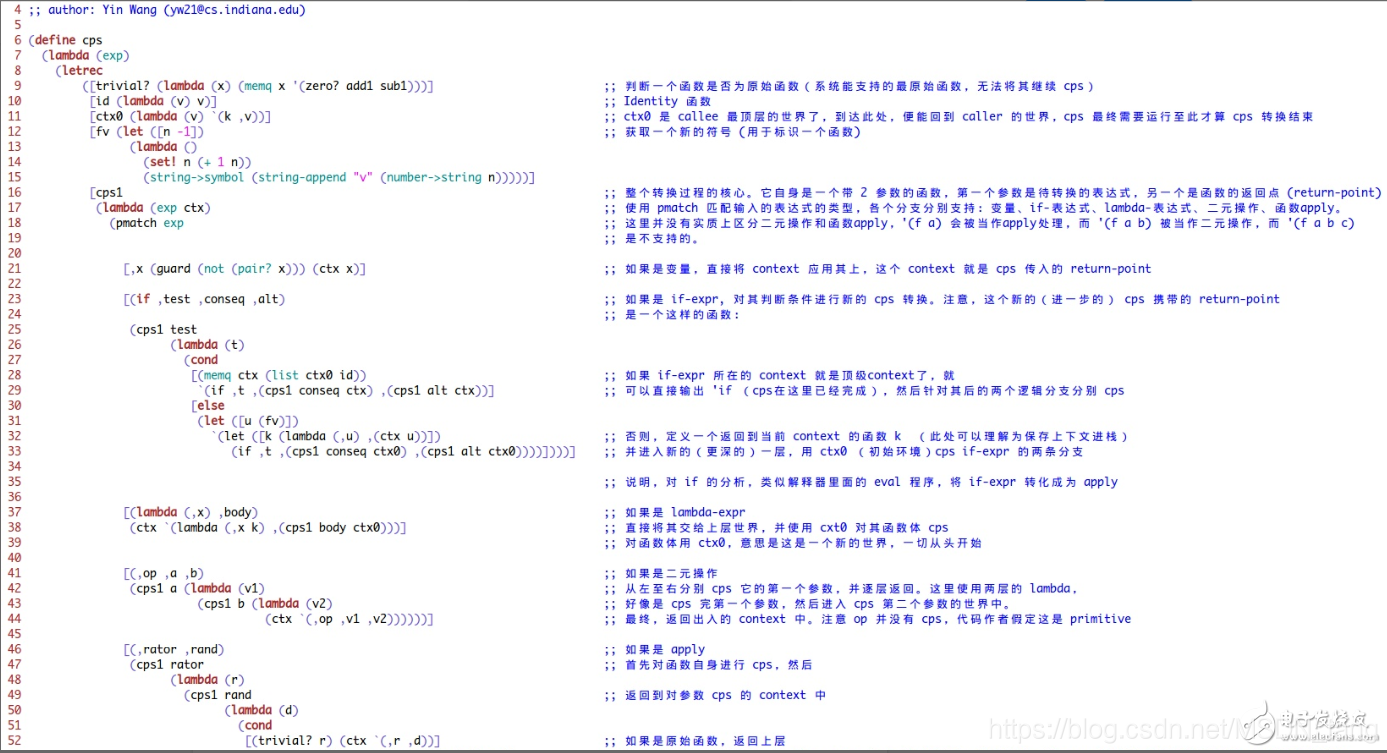最近接触到一些关于CPS编程风格的东西,就去看了看曾今轰动一时的王垠四十行代码,看完有种隔行如隔山的感觉。目前只知道这些代码能够自动把一个递归函数转化成尾递归的形式,其他的就一窍不通了,只能先把代码本身保存下来以后再研究了
;; A simple CPS transformer which does proper tail-call and does not
;; duplicate contexts for if-expressions.
;; author: Yin Wang ([email protected])
(load "pmatch.scm")
(define cps
(lambda (exp)
(letrec
([trivial? (lambda (x) (memq x '(zero? add1 sub1)))]
[id (lambda (v) v)]
[ctx0 (lambda (v) `(k ,v))] ; tail context
[fv (let ([n -1])
(lambda ()
(set! n (+ 1 n))
(string->symbol (string-append "v" (number->string n)))))]
[cps1
(lambda (exp ctx)
(pmatch exp
[,x (guard (not (pair? x))) (ctx x)]
[(if ,test ,conseq ,alt)
(cps1 test
(lambda (t)
(cond
[(memq ctx (list ctx0 id))
`(if ,t ,(cps1 conseq ctx) ,(cps1 alt ctx))]
[else
(let ([u (fv)])
`(let ([k (lambda (,u) ,(ctx u))])
(if ,t ,(cps1 conseq ctx0) ,(cps1 alt ctx0))))])))]
[(lambda (,x) ,body)
(ctx `(lambda (,x k) ,(cps1 body ctx0)))]
[(,op ,a ,b)
(cps1 a (lambda (v1)
(cps1 b (lambda (v2)
(ctx `(,op ,v1 ,v2))))))]
[(,rator ,rand)
(cps1 rator
(lambda (r)
(cps1 rand
(lambda (d)
(cond
[(trivial? r) (ctx `(,r ,d))]
[(eq? ctx ctx0) `(,r ,d k)] ; tail call
[else
(let ([u (fv)])
`(,r ,d (lambda (,u) ,(ctx u))))])))))]))])
(cps1 exp id))))
;;; tests
;; var
(cps 'x)
(cps '(lambda (x) x))
(cps '(lambda (x) (x 1)))
;; no lambda (will generate identity functions to return to the toplevel)
(cps '(if (f x) a b))
(cps '(if x (f a) b))
;; if stand-alone (tail)
(cps '(lambda (x) (if (f x) a b)))
;; if inside if-test (non-tail)
(cps '(lambda (x) (if (if x (f a) b) c d)))
;; both branches are trivial, should do some more optimizations
(cps '(lambda (x) (if (if x (zero? a) b) c d)))
;; if inside if-branch (tail)
(cps '(lambda (x) (if t (if x (f a) b) c)))
;; if inside if-branch, but again inside another if-test (non-tail)
(cps '(lambda (x) (if (if t (if x (f a) b) c) e w)))
;; if as operand (non-tail)
(cps '(lambda (x) (h (if x (f a) b))))
;; if as operator (non-tail)
(cps '(lambda (x) ((if x (f g) h) c)))
;; why we need more than two names
(cps '(((f a) (g b)) ((f c) (g d))))
;; factorial
(define fact-cps
(cps
'(lambda (n)
((lambda (fact)
((fact fact) n))
(lambda (fact)
(lambda (n)
(if (zero? n)
1
(* n ((fact fact) (sub1 n))))))))))
;; print out CPSed function
(pretty-print fact-cps)
;; =>
;; '(lambda (n k)
;; ((lambda (fact k) (fact fact (lambda (v0) (v0 n k))))
;; (lambda (fact k)
;; (k
;; (lambda (n k)
;; (if (zero? n)
;; (k 1)
;; (fact
;; fact
;; (lambda (v1) (v1 (sub1 n) (lambda (v2) (k (* n v2))))))))))
;; k))
((eval fact-cps) 5 (lambda (v) v))
;; => 120
附上注释
